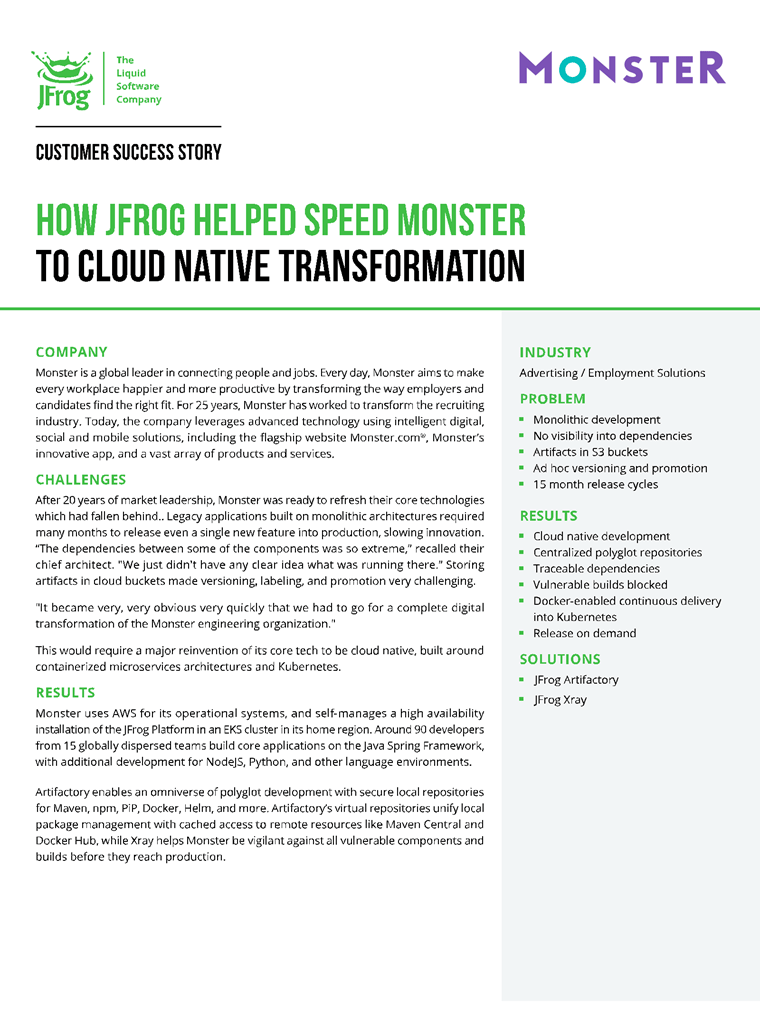Customer Success Story: Monster
How JFrog Helped Speed Monster to Cloud Native Transformation

COMPANY
Monster is a global leader in connecting people and jobs. Every day, Monster aims to make every workplace happier and more productive by transforming the way employers and candidates find the right fit. For 25 years, Monster has worked to transform the recruiting industry. Today, the company leverages advanced technology using intelligent digital, social and mobile solutions, including the flagship website Monster.com®, Monster’s innovative app, and a vast array of products and services.
CHALLENGES
After 20 years of market leadership, Monster was ready to refresh their core technologies which had fallen behind.. Legacy applications built on monolithic architectures required many months to release even a single new feature into production, slowing innovation. “The dependencies between some of the components was so extreme,” recalled their chief architect. “We just didn’t have any clear idea what was running there.” Storing artifacts in cloud buckets made versioning, labeling, and promotion very challenging.
“It became very, very obvious very quickly that we had to go for a complete digital transformation of the Monster engineering organization.”
This would require a major reinvention of its core tech to be cloud native, built around containerized microservices architectures and Kubernetes.
RESULTS
Monster uses AWS for its operational systems, and self-manages a high availability installation of the JFrog Platform in an EKS cluster in its home region. Around 90 developers from 15 globally dispersed teams build core applications on the Java Spring Framework, with additional development for NodeJS, Python, and other language environments.
Artifactory enables an omniverse of polyglot development with secure local repositories for Maven, npm, PiP, Docker, Helm, and more. Artifactory’s virtual repositories unify local package management with cached access to remote resources like Maven Central and Docker Hub, while Xray helps Monster be vigilant against all vulnerable components and builds before they reach production.
“For any one [human] resource that can manage multiple repos, we would need about 3 resources to do this with [multiple] best of breed solutions.” To enable scaling to demand, “a lot of other solutions just weren’t up to snuff.”
Using the JFrog build integration for Jenkins, Monster promotes cloud native builds through Artifactory repositories for development, testing (including Xray vulnerability scanning), and staging. Spinnaker pulls from private Docker registries in Artifactory to deliver services into K8s clusters in AWS and elsewhere for canary testing and production.
Instead of a 15-month cycle, Monster boasts that “today, we can release virtually on request.”

“It’s a massive enabler of efficiency from an architectural perspective. Having the ability to put this into a centralized, well-governed repository where everybody can access that with certain controls and having the security and the labeling in place is essential for Monster to be as reactive, as fast as we can.”
– Martin Eggenberger, Chief Architect, Monster
INDUSTRY
Advertising / Employment Solutions
PROBLEM
- Monolithic development
- No visibility into dependencies
- Artifacts in S3 buckets
- Ad hoc versioning and promotion
- 15 month release cycles
RESULTS
- Cloud native development
- Centralized polyglot repositories
- Traceable dependencies
- Vulnerable builds blocked
- Docker-enabled continuous delivery into Kubernetes
- Release on demand
SOLUTIONS
- Artifactory
- Xray




